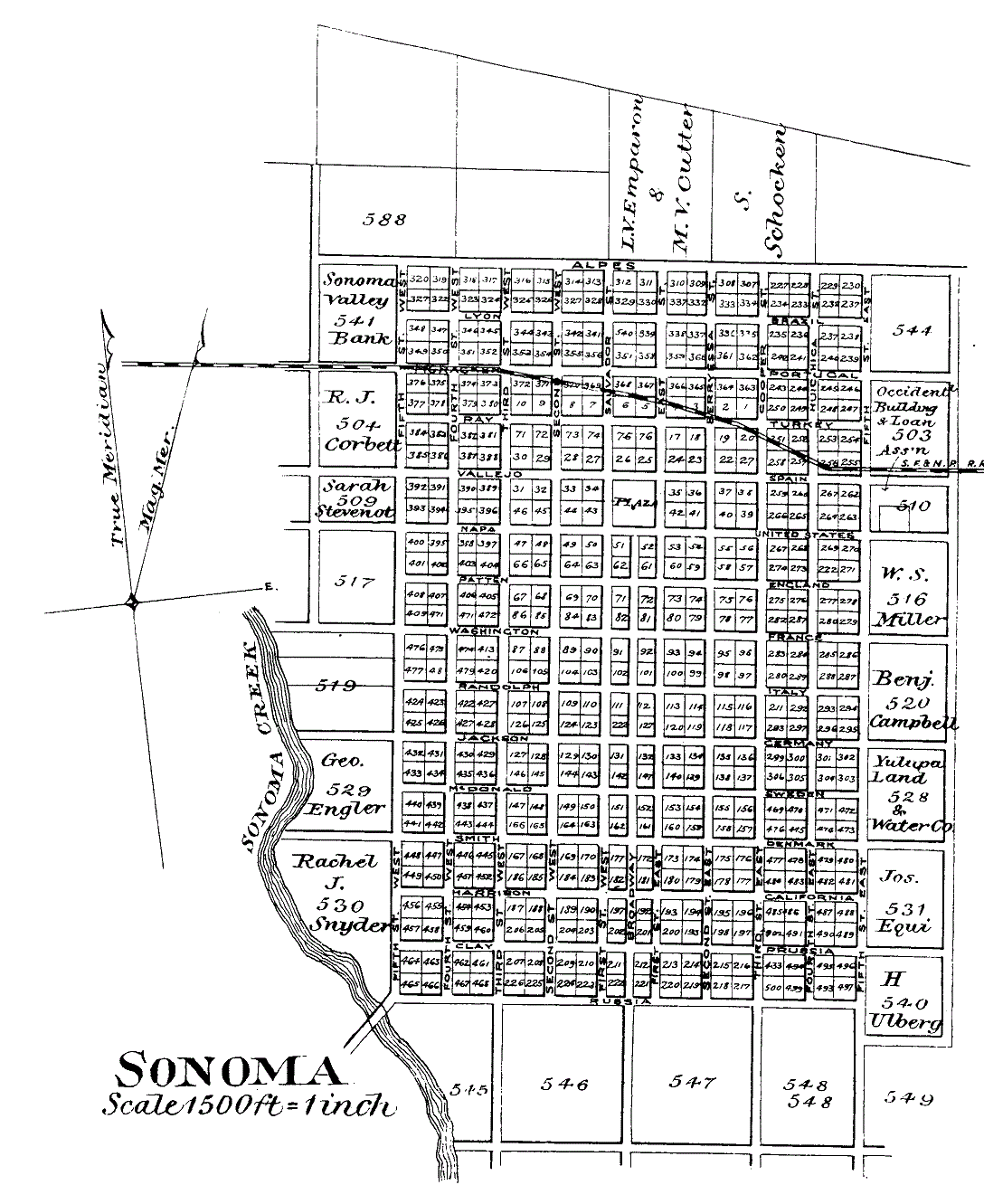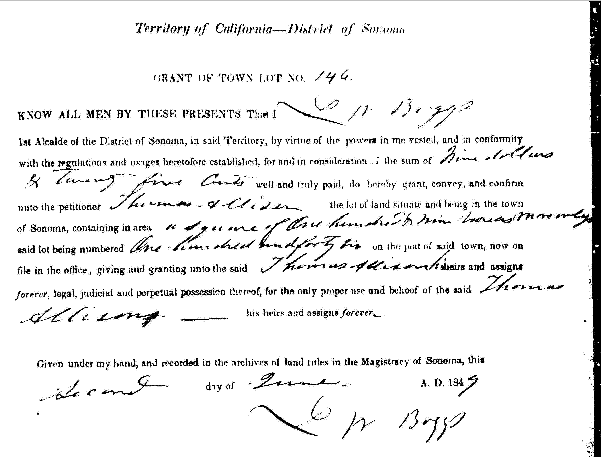
He [Vallejo] was his own engineer and surveyor, for none was attached to the force he
commanded; but with the simple aid of a pocket compass and line he divided the site of the
future city of Sonoma into lots, laid out streets, allotted public parks, and otherwise founded the
pueblo, and established permanently the military command of the northern frontier of California.
Land grants made between 1846 and 1850 still exist and are in the custody of the Sonoma County
Recorder. Some of these early grants were written in Spanish and are still to be transcribed and
abstracted. The documents are contained in five volumes.
The Historical Atlas Map of Sonoma County [1877](2) contains a map of the town of Sonoma as
originally laid out by Vallejo and is included here so it is possible to locate the property for
those grants where a lot number is given (the vast majority). In general, there are three
commonly found lot sizes in the town around the plaza. The most common lot size is 109 varas
square. The vara is a term of measurement commonly used in early Spanish land records. One
vara is equal to 31 inches, therefore the most common lot is about 290 feet on each side. There
are also some lots which measure 89 x 109 varas and some that measure 54½ x 109 varas.
Around the perimeter of the town some larger lots are measured in acres.

Early History of the Town of Sonoma
During the fifteen years preceding California statehood, the area north of San Francisco was
dominated primarily by two factors. First, the Mission San Francisco Solano de Sonoma, the
northernmost mission in California, was consecrated July 4, 1823. By 1830, one thousand
Indians resided and worked at the mission . Then, four years later, Governor Jose Figueroa sent
General Mariano Guadalupe Vallejo, who was then Commander of the Presidio at San Francisco,
to Sonoma. Vallejo's directive as Military Commander and Director of Colonization of the
Northern Frontier was to take charge of the mission, "reduce it to the status of a parish church,
free the Indian workers, and distribute the mission lands and other assets among the population at
large."(3)
[In 1836 Vallejo was named] Commandante General of all Mexican military forces in California,
and though this title was later changed, Vallejo remained the undisputed ruler north of San
Francisco Bay as long a California remained a Mexican Province. He surveyed and established
the Pueblo of Sonoma, gave land grants to private citizens, and directed military affairs.(4)
The grants that were written in English and still exist from that time period follow one of three
standard forms. Those written in Grants, Volume 2-A, are completely handwritten and follow
the model of Jesse L. Beasley transcribed as follows.
|
"Know all men by these presents that I John H. Nash Chief Justice of the District of Sonoma Upper California, in virtue of the powers vested in me have in accordance with the law that has in such case been made and provided and the visage that has obtained, granted upon the petition of Jesse L. Beasley, a citizen of the town of Sonoma, and do by these presents, grant unto him the said Jesse L. Beasley, his heirs and assigns forever on the following conditions, and not otherwise, certain lots or parcels of land, belonging to the town of Sonoma, containing each one hundred varas square, more or less, as described on the plan of said town, to wit The southwest quarter of section no.1 north R2 east; and the north west quarter of section No. 2 East. The said conditions are that said Jesse L. Beasley shall within one year from the date hereof, build a house upon, and inclose with a fence or ditch, the said lots, and shall not obstruct running water which may be necessary for common use and shall in all things comply with the laws and the usage as aforesaid. "To have and to hold the above granted premises, on compliance with the conditions as
aforesaid, to him the said Jesse L. Beasley, his heirs and assigns, in the quite and proper use and
benefit thereof forever.
"In testimony whereof I do this twenty-sixth day of March in the year of our Lord one thousand eight hundred and forty-seven office at Sonoma hereunto set my hand and affix my signature, there being no seal office. Signed John H. Nash Chief Justice
A record made by me of aforegoing deed on the 24th day of April A.D. 1847 John H. Nash J. P." |
The documents in books A and B are written on pre-printed forms.The reader will note the term "Alcalde" is used to identify the person who issues the grants. An
Alcalde is the chief administrative and judicial officer of a Spanish or Spanish-American town.


Acknowledgments
Appreciation is expressed to Audrey Herman, former Sonoma County Archivist, for suggesting
that this project be undertaken, and to Bernice Peterson, Sonoma County Recorder, for making
the records available.
The actual tasks of abstracting and transcribing the records were done by the following persons:
Doris Dickenson
Carmen Finley
Virginia Hershey
Jeanne Taylor
1. History of Sonoma County [Cal.] including its geology, topography, mountains, valleys and
streams; with a full and particular record of the Spanish grants; its early history and settlement.
(San Francisco: Alley, Bowen & Co., 1880) pp. 444-445.
2. 3. 4.
Copyright 2000 by Sonoma County Genealogical Society, Carmen J. Finley, Projects Director